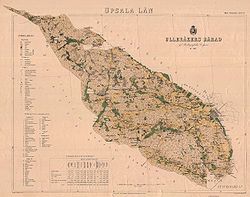
Ulleråker Hundred
Encyclopedia

Uppland
Uppland is a historical province or landskap on the eastern coast of Sweden, just north of Stockholm, the capital. It borders Södermanland, Västmanland and Gästrikland. It is also bounded by lake Mälaren and the Baltic sea...
and Uppsala County
Uppsala County
Uppsala County is a county or län on the eastern coast of Sweden. It borders the counties of Stockholm, Södermanland, Västmanland, Gävleborg, and the Baltic Sea.- Province :For History, Geography and Culture see: Uppland...
in Sweden
Sweden
Sweden , officially the Kingdom of Sweden , is a Nordic country on the Scandinavian Peninsula in Northern Europe. Sweden borders with Norway and Finland and is connected to Denmark by a bridge-tunnel across the Öresund....
.
The area of the hundred stretches from the border of Hagunda hundred in the south-west to the Rivers Jumkil and Fyris
Fyris
Fyrisån is a river in the Swedish province of Uppland, which passes through the city of Uppsala and ends in Lake Mälaren....
in the northwest and Lake Ekoln
Ekoln
Ekoln constitutes the northernmost gulf of Lake Mälaren, Sweden. On its northern shore are the southern suburbs of Uppsala and the mouth of River Fyris....
in the south-east. The area of the hundred was described by Wilhelm Tham in 1850 as consisting of mostly unforested fields with occasional swampy areas around the streams which flow into the Fyris or Lake Ekoln.
The medieval Ullarakers hundare (the name later changed into Ulleråker) had its name after Ullaraker, the place of the thing
Thing (assembly)
A thing was the governing assembly in Germanic and introduced into some Celtic societies, made up of the free people of the community and presided by lawspeakers, meeting in a place called a thingstead...
, which was close to the Church of the Holy Trinity or the Castle in Uppsala. The hundred consisted of the parishes of Bondkyrka, Börje
Börje
Börje is a male given name and a variant of Birger. Børge is the Danish and Norwegian spelling.- People with the given name Börje :*Börje Ahlstedt , a Swedish actor*Börje Ekedahl , a Swedish bobsledder...
, Jumkil, Läby
Läby
Läby is a locality situated in Uppsala Municipality, Uppsala County, Sweden with 230 inhabitants in 2005....
, Näs and Vänge
Vänge
Vänge, previous known as Brunna, is a locality situated in Uppsala Municipality, Uppsala County, Sweden with 1,245 inhabitants in 2005.-See also:*Uppland Runic Inscription 905...
.
The hundred was (1920) part of the middle court district of Uppsala County, Tiunda tingslag and Tiunda bailliwick. In the 19th and early 20th centuries it consisted of the parishes of Bondkyrka, Börje
Börje
Börje is a male given name and a variant of Birger. Børge is the Danish and Norwegian spelling.- People with the given name Börje :*Börje Ahlstedt , a Swedish actor*Börje Ekedahl , a Swedish bobsledder...
, Uppsala-Näs, Vänge
Vänge
Vänge, previous known as Brunna, is a locality situated in Uppsala Municipality, Uppsala County, Sweden with 1,245 inhabitants in 2005.-See also:*Uppland Runic Inscription 905...
, Läby
Läby
Läby is a locality situated in Uppsala Municipality, Uppsala County, Sweden with 230 inhabitants in 2005....
, and one half of Jumkil, of which the other half belonged to Bälinge Hundred.
The antiquities in Ulleråker Hundred were described by the antiquarian Johan Peringskiöld
Johan Peringskiöld
Johan Peringskiöld was born in Strängnäs and died in Stockholm .His father was Lars Fredrik Peringer, a senior master at the gymnasium and his mother Anna Maria Mulich. He began his studies at Uppsala University in 1677 and he was an ardent student of the national antiquities...
in his large, illustrated work Monumenta ullerakeriensia, published in 1719.
Ulleråker is also the name of a deanery
Dean (religion)
A dean, in a church context, is a cleric holding certain positions of authority within a religious hierarchy. The title is used mainly in the Anglican Communion and the Roman Catholic Church.-Anglican Communion:...
in the Archdiocese of Uppsala
Archdiocese of Uppsala
The Archdiocese of Uppsala, Lutheran 'successor' to the former Roman Catholic Swedish province, is one of the thirteen dioceses of the Church of Sweden and the only one having the status of an archdiocese.-Lutheran archdiocese:...
.
The name
The name is first recorded in Old NorseOld Norse
Old Norse is a North Germanic language that was spoken by inhabitants of Scandinavia and inhabitants of their overseas settlements during the Viking Age, until about 1300....
literature as Ullarakr (the late twelfth century in the case of Krákumál
Krákumál
Krákumál or the Lay of Kraka is a skaldic poem, consisting of a monologue in which Ragnar Lodbrok is dying in Ælla's snake pit and looks back at a life full of heroic deeds. It was composed in the 12th century, "almost certainly" in the Scottish islands...
, and 1225 in the case of Heimskringla
Heimskringla
Heimskringla is the best known of the Old Norse kings' sagas. It was written in Old Norse in Iceland by the poet and historian Snorri Sturluson ca. 1230...
). In Sweden, where written sources appear much later than on Iceland, the first appearance is in 1298 as Vllarakir. The first element is the genitive case of the name of the Norse
Norse mythology
Norse mythology, a subset of Germanic mythology, is the overall term for the myths, legends and beliefs about supernatural beings of Norse pagans. It flourished prior to the Christianization of Scandinavia, during the Early Middle Ages, and passed into Nordic folklore, with some aspects surviving...
god Ullr
Ullr
In early Germanic paganism, *Wulþuz appears to have been a major god, or an epithet of an important god, in prehistoric times....
. The last element is åker m "field, acre".

